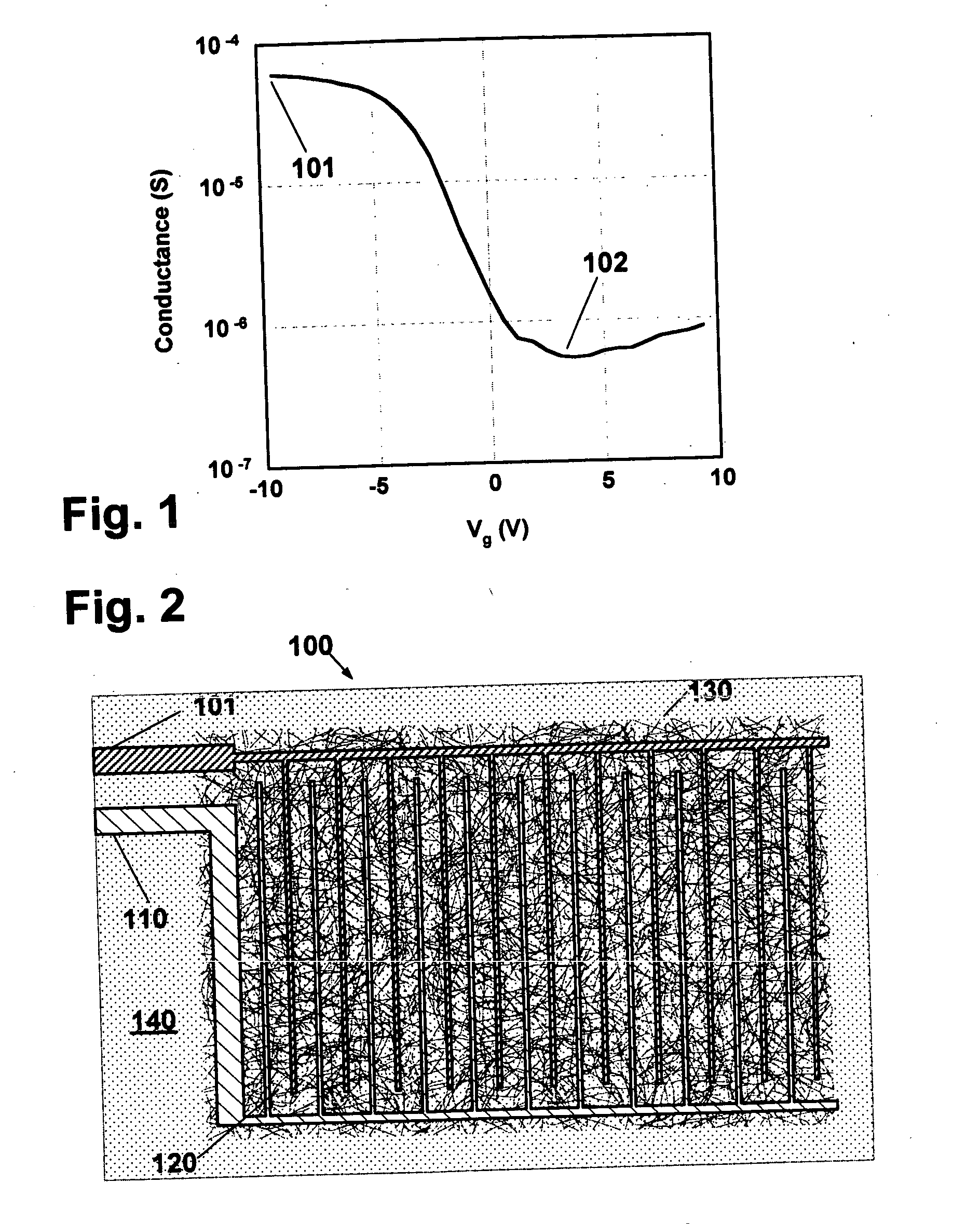Nanotube sensor devices for DNA detection
a dna detection and nanotube technology, applied in the field of sensors, can solve the problems of expensive, slow, complex, unlikely to be useful for routine medical testing, and the chemical reaction by which the dna is labeled is expensive and time-consuming
- Summary
- Abstract
- Description
- Claims
- Application Information
AI Technical Summary
Benefits of technology
Problems solved by technology
Method used
Image
Examples
example a
[0087] A degenerately doped silicon wafer with a silicon oxide film was coated with carbon nanotubes in a random network, as described in the earlier-referenced U.S. patent application Ser. No. 10 / 177,929 and generally in accordance with the description hereinabove. Titanium contacts 30 nm thick covered with gold contacts 120 nm thick were deposited and patterned by photolithography and lift-off to form opposing contacts. The contacts each comprised a plurality of interdigitated portions disposed over a generally rectangular region. A network of randomly oriented nanotubes was disposed over the silicon substrate. Nanotubes in the network were in electrical contact with interdigitated portions of the contacts. After the deposition of the contacts, nanotubes outside of the generally rectangular area were removed by oxygen plasma etching, leaving nanotube network remaining. The use of interdigitated sets of metal electrodes with nanotube network interposed generally between the interdi...
example b
Noncovalent Chemical Functionalization of Carbon Nanotube Devices for Single Base Mismatch DNA detection.
[0093] B-1. Summary:
[0094] In one exemplary embodiment having aspects of the invention, a nanotube sensor device comprises a carbon nanotube network field effect transistor (“NTFET” or “NTNFET”) device functionalized with single-stranded DNA (ssDNA). In certain embodiments, single-stranded DNA (ssDNA) may be immobilized on NTFET devices through polymer and polyaromatic molecules non-covalently attached to carbon nanotubes. The significant differences in the electronic response of functionalized NTFETs to complementary single-stranded DNA (cDNA) and single base mismatch single-stranded DNA (sbmDNA) may be measured. This exemplary sensor includes the following structure, elements and functions:
[0095] a) One or more carbon nanotube FET device comprising a single nanotube and / or a networks of nanotubes disposed to form a conducting channel between at least a source and a drain ele...
example c
[0122] DNA assays using nanoelectronic devices.
[0123] A number of different exemplary DNA (or other polynucleotide) assay embodiments having aspects of the invention are shown in FIGS. 8-12. The structure and methods shown are exemplary, and other alternative embodiments may use structures and methods described elsewhere in this application. Where the different embodiments include substantially similar elements, the same reference numbers are used to designate such elements in the description of each embodiment.
C-1 Structure:
[0124] As shown in FIGS. 8-9, and also in FIGS. 10-12, the sensor 10 comprises a platform having at least one nanostructure, such as nanotube 12 disposed adjacent substrate 14 and in electrical communication between at least a source electrode 16 and a drain electrode 18.
[0125] Optionally, the device may include at least one additional electrode, such as gate electrode 20 disposed adjacent nanotube 12. The gate electrode 20 is shown embedded in substrate 14...
PUM
| Property | Measurement | Unit |
|---|---|---|
| gate voltage | aaaaa | aaaaa |
| gate voltage | aaaaa | aaaaa |
| gate voltages | aaaaa | aaaaa |
Abstract
Description
Claims
Application Information
 Login to View More
Login to View More - R&D
- Intellectual Property
- Life Sciences
- Materials
- Tech Scout
- Unparalleled Data Quality
- Higher Quality Content
- 60% Fewer Hallucinations
Browse by: Latest US Patents, China's latest patents, Technical Efficacy Thesaurus, Application Domain, Technology Topic, Popular Technical Reports.
© 2025 PatSnap. All rights reserved.Legal|Privacy policy|Modern Slavery Act Transparency Statement|Sitemap|About US| Contact US: help@patsnap.com



